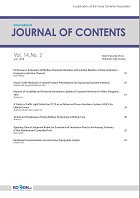- Log In/Sign Up
- P-ISSN1738-6764
- E-ISSN2093-7504
- KCI
 ISSN : 1738-6764
ISSN : 1738-6764
Vol.4 No.2
Abstract
Pre schools with state of the art facilities that would provide not just academic excellence but also ensure the safety and provide efficient healthcare to their pupils relative to Atopic Dermatitis with Asthma is the main objective of this research One of the most promising applications of sensor networks is for human healthcare monitoring. Due to recent technological advances in sensor, low power microelectronics and miniaturization, and wireless networking enable the design and proliferation of this wireless sensor networks capable of autonomously monitoring and controlling environments. Thus, this research presents the utilization of such microelectronic sensor and plots the hardware and software architecture of a wireless sensor network system with real-time pupil monitoring that integrates vital sign sensors, location sensor and allergen sensor. This proposed architecture for wearable sensors can be used as active tags which can track pupil’s location within the school’s premises, identify possible atopic dermatitis with asthma allergens, it would monitor and generate a health status report of the pupil.
Abstract
In this paper, we present a real-time physical simulation model of water surfaces with a novel method to represent the water mass flow in full three dimensions. In a physical simulation model, the state of the water surfaces is represented by a set of physical values, including height, velocity, and the gradient. The evolution of the velocity field in previous works is handled by a velocity solver based on the Navier-Stokes equations, which occurs as a result of the unevenness of the velocity propagation. In this paper, we integrate the principle of the mass conservation in a fluid of equilateral density to upgrade the height field from the unevenness, which in mathematical terms can be represented by the divergence operator. Thus the model generates waves induced by horizontal velocity, offering a simulation that puts forces added in all direction into account when calculating the values for height and velocity for the next frame. Other effects such as reflection off the boundaries, and interactions with floating objects are involved in our method. The implementation of our method demonstrates to run with fast speed scalable to real-time rates even for large simulation domains. Therefore, our model is appropriate for a real-time and large scale water surface simulation into which the animator wishes to visualize the global fluid flow as a main emphasis.
Abstract
A load sharing algorithm is one of the important factors in computer system. In sender-initiated load sharing algorithms, when a distributed system becomes to heavy system load, it is difficult to find a suitable receiver because most processors have additional tasks to send. The sender continues to send unnecessary request messages for load transfer until a receiver is found while the system load is heavy. Because of these unnecessary request messages it results in inefficient communications, low cpu utilization, and low system throughput. To solve these problems, we propose a self-adjusting evolutionary algorithm for improved sender-initiated load sharing in distributed systems. This algorithm decreases response time and increases acceptance rate. Compared with the conventional sender-initiated load sharing algorithms, we show that the proposed algorithm performs better.
Abstract
This paper presents a novel method to construct a personalized e-Learning system based on dynamic estimations of item parameters and learners’ abilities, where the learning content objects are of the same intrinsic quality or homogeneously distributed and the estimations are carried out using IRT(Item Response Theory). The system dynamically connects the test and the corresponding learning procedures. Test results are directly applied to estimate examinee’s ability and are used to modify the item parameters and the difficulties of learning content objects during the learning procedure is being operated. We define the learning unit ‘Node’ as an amount of learning objects operated so that new parameters can be re-estimated. There are various content objects in a Node and the parameters estimated at the end of current Node are directly applied to the next Node. We offer the most appropriate learning Node for a person’s ability throughout the estimation processes of IRT. As a result, this scheme improves learning efficiency in web-base e-Learning environments offering the most appropriate learning objects and items to the individual students according to their estimated abilities. This scheme can be applied to any e-Learning subject having homogeneous learning objects and unidimensional test items. In order to construct the system, we present an operation scenario using the proposed system architecture with the essential databases and agents.
Abstract
In this paper, we propose a new approach for content-based video retrieval using non-parametric based motion classification in the shot-based video indexing structure. Our system proposed in this paper has supported the real-time video retrieval using spatio-temporal feature comparison by measuring the similarity between visual features and between motion features, respectively, after extracting representative frame and non-parametric motion information from shot-based video clips segmented by scene change detection method. The extraction of non-parametric based motion features, after the normalized motion vectors are created from an MPEG-compressed stream, is effectively fulfilled by discretizing each normalized motion vector into various angle bins, and by considering the mean, variance, and direction of motion vectors in these bins. To obtain visual feature in representative frame, we use the edge-based spatial descriptor. Experimental results show that our approach is superior to conventional methods with regard to the performance for video indexing and retrieval.
